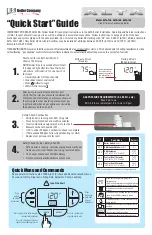
Page 26
Figure 18. Test Port - ULC-S636 system
3.D Common Venting
High efficiency boilers and water heaters up to
500 MBTU/H may be common vented using Non-Return
Valve kits and Centrotherm InnoFlue polypropylene
venting. Go online to the manufacturer’s website and
refer to the Common Venting Installation Instructions,
document number 1427, for instructions on sizing and
installing a common venting system.
If common venting is required on larger model sizes or
with different venting materials, it MUST be engineered
by a competent venting specialist, and involves the
selection of draft inducing equipment, hardware and
controls to properly balance flue gas pressures. Do
not common vent these units unless the vent system
meets this requirement. High efficiency class IV units
are never permitted to share a vent with Category I
appliances.
3.E Locating Vent and Combustion Air
Terminals
Side Wall Vent Terminal
The appropriate side wall vent terminal must be used.
The terminal must be located in accordance with
ANSI Z223.1/NFPA 54 and applicable local codes. In
Canada, the installation must be in accordance with
CSA B149.1 or .2 and local applicable codes. Consider
the points listed on the following page when installing
the terminal.
1. Figure 20 shows the requirements for mechanical
vent terminal clearances for the U.S. and Canada.
The outdoor models must be installed at least 10
ft (the vent pipe) from any door or window that
can be opened. The exhaust vent shall not be
under any overhang or roof. Use only the vent
components included with the boiler.
2. Vent terminals for condensing appliances or
appliances with condensing vents are
not
permitted to terminate above a public walkway,
or over an area where condensate or vapor could
create a nuisance or hazard.
3. Locate the vent terminal so that vent gases cannot
be drawn into air conditioning system inlets.
4. Locate the vent terminal so that vent gases cannot
enter the building through doors, windows, gravity
inlets or other openings. Whenever possible, avoid
locations under windows or near doors.
5.
Locate the vent terminal so that it cannot be
blocked by snow. The installer may determine
that a vent terminal must be higher than the
minimum shown in codes, depending upon
local conditions.
6. Locate the terminal so the vent exhaust does
not settle on building surfaces or other nearby
objects. Vent products may damage surfaces or
objects.
7. If the boiler or water heater uses ducted
combustion air from an intake terminal located on
the same wall.
If the vent termination is located in an area exposed to
high winds, an optional PVC tee (the same diameter as
the vent pipe) may be used. The tee’d vent termination
offers greater protection from wind related operating
issues.
Side Wall Combustion Air Terminal
The side wall combustion air terminal, or concentric
terminal must be used when the heater takes air from
a side wall. (See page 23 ) Contact manufacturer
for AL29-4C termination fittings. Consider the following
when installing the terminal. (See Figure 20 through
Figure 21.)
1. Do not locate the air inlet terminal near a source
of corrosive chemical fumes (e.g., cleaning fluid,
chlorine compounds, etc.)
2. Locate the terminal so that it will not be subject to
damage by accident or vandalism. It must be at
least 7 feet (2.1m) above a public walkway.
3. Locate the combustion air terminal so that it
cannot be blocked by snow. The National Fuel
Gas Code requires that it be at least 12 inches
(30cm) above grade, but the installer may
determine it should be higher, depending upon
local conditions.
LAARS Heating Systems
Summary of Contents for NEOTHERM NTH
Page 4: ...LAARS Heating Systems ...
Page 36: ...Page 36 Figure 22 Hydronic Piping Single Boiler Zoning with Circulators LAARS Heating Systems ...
Page 52: ...Page 52 Figure 36 Ladder Diagram 7 H Ladder Diagram LAARS Heating Systems ...
Page 100: ...Page 100 Parts Illustration 4 Internal Components Sizes 750 850 LAARS Heating Systems ...
Page 102: ...Page 102 Parts Illustration 6 Gas Train Components Sizes 600 850 LAARS Heating Systems ...
















































